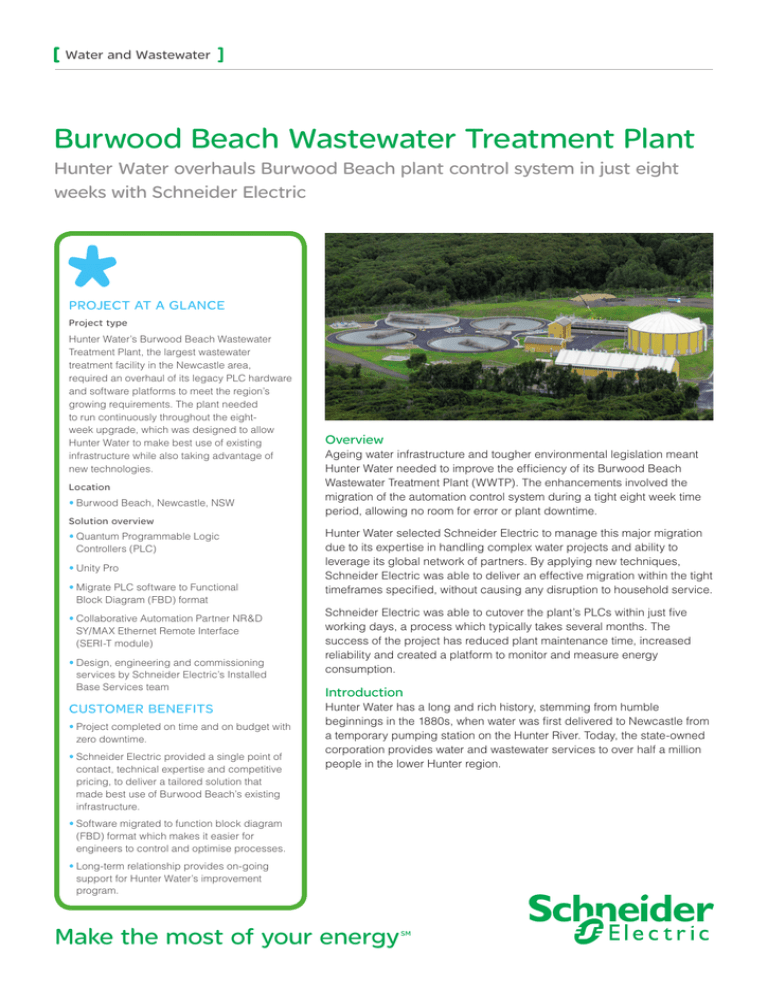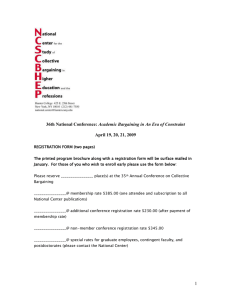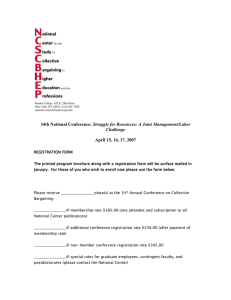
Water and Wastewater
Burwood Beach Wastewater Treatment Plant
Hunter Water overhauls Burwood Beach plant control system in just eight
weeks with Schneider Electric
PrOjECT AT A GLANCE
Project type
Hunter Water’s Burwood Beach Wastewater
Treatment Plant, the largest wastewater
treatment facility in the Newcastle area,
required an overhaul of its legacy PLC hardware
and software platforms to meet the region’s
growing requirements. The plant needed
to run continuously throughout the eightweek upgrade, which was designed to allow
Hunter Water to make best use of existing
infrastructure while also taking advantage of
new technologies.
Location
•Burwood Beach, Newcastle, NSW
Solution overview
•Quantum Programmable Logic
Controllers (PLC)
•Unity Pro
•Migrate PLC software to Functional
Block Diagram (FBD) format
•Collaborative Automation Partner NR&D
SY/MAX Ethernet Remote Interface
(SERI-T module)
•Design, engineering and commissioning
services by Schneider Electric’s Installed
Base Services team
customer benefits
•Project completed on time and on budget with
zero downtime.
•Schneider Electric provided a single point of
contact, technical expertise and competitive
pricing, to deliver a tailored solution that
made best use of Burwood Beach’s existing
infrastructure.
Overview
Ageing water infrastructure and tougher environmental legislation meant
Hunter Water needed to improve the efficiency of its Burwood Beach
Wastewater Treatment Plant (WWTP). The enhancements involved the
migration of the automation control system during a tight eight week time
period, allowing no room for error or plant downtime.
Hunter Water selected Schneider Electric to manage this major migration
due to its expertise in handling complex water projects and ability to
leverage its global network of partners. By applying new techniques,
Schneider Electric was able to deliver an effective migration within the tight
timeframes specified, without causing any disruption to household service.
Schneider Electric was able to cutover the plant’s PLCs within just five
working days, a process which typically takes several months. The
success of the project has reduced plant maintenance time, increased
reliability and created a platform to monitor and measure energy
consumption.
Introduction
Hunter Water has a long and rich history, stemming from humble
beginnings in the 1880s, when water was first delivered to Newcastle from
a temporary pumping station on the Hunter River. Today, the state-owned
corporation provides water and wastewater services to over half a million
people in the lower Hunter region.
•Software migrated to function block diagram
(FBD) format which makes it easier for
engineers to control and optimise processes.
•Long-term relationship provides on-going
support for Hunter Water’s improvement
program.
Make the most of your energy
SM
Water and Wastewater
Hunter Water overhauls plant control system
The Burwood Beach WWTP is Hunter Water’s
largest wastewater treatment facility, treating
an average daily flow of 44 million litres and
servicing approximately 180,000 people – 25
per cent of Hunter Water’s customers.
Upgrading Burwood Beach
In September 2009, Hunter Water began
upgrading Burwood Beach WWTP to provide
additional processing capacity and improve the
reliability of equipment. The project is part of a
five year program that will see approximately
$700 million invested in water and wastewater
improvement projects across the Hunter
and Newcastle area. These projects are
designed to meet the growing requirements of
customers and run plants in accordance within
guidelines issued by the Office of Environment
and Heritage.
“By involving partners such as
NR&D and providing a single
point of contact, Schneider
Electric removed the headaches
traditionally associated with
projects of this nature.”
—Mark Mills, Manager Electrical & Mechanical,
Hunter Water
As part of the project Hunter Water needed
to upgrade the legacy SY/MAX PLC hardware
and software platform used at Burwood
Beach for the automation of electromechanical
processes.
“Parts and engineers trained in our legacy PLC
technology were becoming scarce, which meant
the time taken to replace components was much
longer than it needed to be,” commented Mark
Mills, Manager Electrical & Mechanical at Hunter
Water. “Upgrading the legacy infrastructure was
crucial if we were to keep the plant running in
the most efficient way possible.”
Partnering for success
Hunter Water set a deadline of eight weeks to
complete the migration to minimise disruption
to plant operations and the service delivered
to local residents. Hunter Water was also keen
to ensure the plant ran continuously while
upgrades were being made.
The decision to partner with Schneider Electric
to address these requirements was threefold,
as Mark Mills explained: “Our relationship
with Schneider Electric is far larger than a
single project and we’ve developed a close
partnership with them over the past 20 years.
The team has a detailed understanding of our
organisation and the challenges it faces, which
means they are well prepared to support us in
complex project roll-outs and ensure we get the
best possible outcomes.
“Throughout the plant upgrade, Schneider
Electric was able to apply its learnings from
previous projects to ensure the PLC migration
ran smoothly in the fastest time possible. Finally,
Schneider Electric was able to leverage its
global network of partners, which meant we
could minimise the time and resources involved
in engaging multiple suppliers.”
Water and Wastewater
Hunter Water overhauls plant control system
A two staged approach
One of the upgrade requirements was to generate new PLC software
from Ladder Logic into Functional Block Diagram (FBD) format. FBD is a
programming language that performs open-loop and closed-loop control
functions. This makes it easier for engineers to conduct calculations of
engineering concepts, in feedback and control, to optimise processes.
Upgrading the PLC software from Ladder Logic to FBD format typically
takes time that wasn’t possible, given the short time frame for migration.
Schneider Electric suggested an alternative staged approach, that
would allow the timely upgrade of the hardware, with the development of
a new functional specification and the software into FBD format to follow
soon after.
“To deliver on its promises Schneider Electric called on the support
of its Collaborative Automation Partner NR&D (Niobrara Research &
Development),” explained Mills. “NR&D worked seamlessly with Schneider
Electric to supply its SERI-T module – a SY/MAX Ethernet Remote
Interface – that enabled better connectivity and information flow between
different parts of the plant.”
Hardware upgrade
The old control system consisted of a SY/MAX Model 450 processor
with 14 remote racks, installed in several panels throughout the plant and
connected to the processor via Local Interface (LI) and Remote Interface
(RI) modules. A smaller PLC, SY/MAX Model 50, was also used for the
plant’s odour control system.
The upgrade involved the replacement of
the old processor rack and eight of the 14
remote racks, and the Model 50 PLC, with
Quantum Unity PLC hardware. The other six
SY/MAX racks remained, but were controlled
by the new Quantum PLC by using the NR&D
SERI-T module.
To ensure minimal plant disruption, installation
was achieved in approximately 45 minutes.
This involved installation of the SERI-T
modules in each of the remote racks and the
reinstatement of the plant to a working status
when the processor was switched from
SY/MAX to Quantum.
“The first phase of the migration process was very efficient, taking
less than an hour, instead of the typical time frame of several days.”
commented Mills. “Furthermore, all racks apart from one were cutover
within five working days; a process that can normally take months
of work.”
On time, on budget and without downtime
CLIPCOM 23488
By avoiding the traditional ‘rip and replace’ mentality, Schneider Electric
was able to help Hunter Water make best use of its existing infrastructure.
As a result, the control system implemented by Schneider Electric was
completed within a demanding eight-week schedule and came in on
budget. The cut-over strategy also meant the migration project avoided
any downtime so the impact on households was nil.
“The first phase of the
migration process was very
efficient, taking less than an
hour, instead of the typical
time frame of several days.”
—Mark Mills, Manager Electrical & Mechanical ,
Hunter Water
Water and Wastewater
Hunter Water overhauls plant control system
Commenting on the migration, Mark Mills
said: “As an operating plant serving a large
proportion of Hunter Water customers, it was
essential Burwood Beach remained operational
throughout the migration process. Schneider
Electric’s technical expertise, strong project
management and competitive pricing meant
that we were able to meet this requirement and
ensure the project was completed within the
tight eight-week schedule
we demanded.”
“By involving partners such as NR&D and
providing a single point of contact, Schneider
Electric removed the headaches traditionally
associated with projects of this nature. As
Schneider Electric’s installed-base services
team oversaw the project through every stage,
we were confident everything was being done to
minimise potential risks of the migration.”
“In the past, parts and technologies in the plant
were replaced on a case-by-case basis. Now
we’ve standardised that with Schneider Electric
products and have the latest infrastructure in
place, the plant is far more reliable and any
operating problems can be tackled quickly and
easily”, said Mills.
Commenting on Schneider Electric’s approach
to the project, Scott Wooldridge, Vice President,
Schneider Electric Industry Business said:
“The Burwood Beach migration project is
an example of the results Schneider Electric
can deliver when truly embedded within an
organisation. Our detailed understanding of the
‘pain points’ facing Hunter Water, combined with
our holistic approach in tackling them, meant we
were able to deliver a complete solution, not just
individual products.”
“This project also demonstrates the skills and
expertise of our installed-base services team
in developing customer-orientated solutions
that reduce capital and operating expenses
while increasing operational efficiency,”
added Wooldridge.
“Now we’ve standardised that with Schneider
Electric products and have the latest infrastructure
in place, the plant is far more reliable...”
—Mark Mills, Manager Electrical & Mechanical ,
Hunter Water
Looking ahead
Together with Hunter Water, Schneider Electric
is delivering innovation and investment
protection to many of Hunter Water’s most
critical assets. This includes supporting the
migration of the organisation’s 12 other plants
over the next five years, to increase plant
reliability and install more efficient technologies.
“This project has laid the foundations for future
work to improve the energy efficiency of the
plant. Long term, we’re looking forward to
working more closely with Schneider Electric on
other projects, that will enable us to monitor and
manage energy more effectively and futureproof our plants against likely consumer and
regulatory requirements,” concluded Mills.
SAUDIAED4WWW003
In the long term, Schneider Electric will continue
to work closely with Hunter Water, so that the
organisation can continue to achieve sustainable
growth while maximising return on investment.
Schneider Electric (Australia) Pty Limited 78 Waterloo Road, Macquarie Park, NSW 2113 Australia Tel: 1300 369 233 Fax: 1300 369 288 www.schneider-electric.com.au
© 2011 Schneider Electric (Australia) Pty Limited. All Rights Reserved.
This document has been printed on recycled paper



